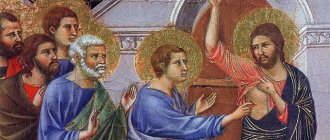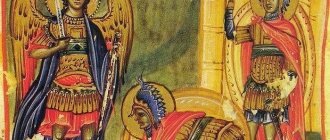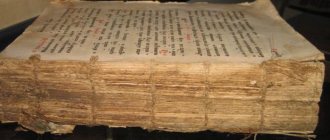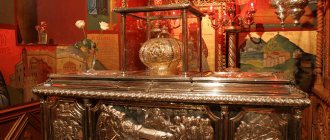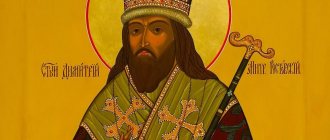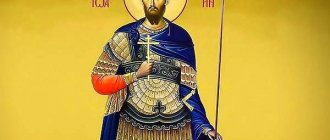| Apostle Simon the Zealot |
Simon the Zealot
or
Canaanite
(c.), Apostle of the 12th Commemorated on May 10 and in the Council of the Twelve Apostles
Came from Cana of Galilee. He was the son of Saint Joseph the Betrothed, the brother of the Lord Jesus Christ in the flesh. The first miracle that the Savior performed - turning water into wine - happened in Simon's house: during the feast there was not enough wine for the guests. Then the Lord, through the intercession of His Most Holy Mother, turned water into wine. Amazed by the miracle, Simon believed with all his heart and soul in the Lord Jesus as the promised Messiah and, leaving everything, followed Him.
Simon became one of the twelve apostles of Christ and received the name “zealot,” that is, a zealot. If his identification with the Apostle Nathanael is correct, then it was Simon the Zealot who was that Israeli from Cana of Galilee in whom, according to the word of the Lord who called him, “there is no guile” [1].
On the day of Pentecost, he, along with the other apostles, received the gift of the Holy Spirit.
He lived in strict fasting, prayed incessantly and glorified Jesus Christ with the help of many miraculous signs. The Holy Apostle Simon preached the teachings of Christ in Judea, Egypt, Libya, Cyrene and Britain [2].
Then, in the 50s AD, he found refuge in Abkhazia, in a secluded corner of Psyrtskhe, where he lived in a cave on the bank of a mountain river. According to legend, he entered his stone cell through a narrow opening in the vault, so as not to tempt ordinary people who would want to see how the foreign ascetic lived. Abkhaz legends say that Simon the Canaanite gradually became known among local residents as a miracle worker who could heal various diseases with the touch of his hands, pacify pain by splashing water on wounds, and improve the fate of the suffering by reading prayers in a mysterious language.
One day, the Roman pagans, who cruelly punished unrecognized Gentiles, tracked down a modest preacher and put him to painful execution. According to some sources, he was crucified on a cross [3], according to others, he was sawed into pieces alive and his head was shown to newly converted Christians [4].
Reverence
| Ark with relics (part of a hand) of St. Apostle Simon the Zealot. Bucharest, Church “Sf. Împăraţi – Podeanu” |
The residents of Psyrtskhi, devoted to the Apostle Simon, asked for permission to bury his body and did this not far from his cave, in the city of Nikopsia.
In the century, Christian Abkhazian rulers decided to build a temple dedicated to him on the relics of the holy apostle. The cathedral was erected in a relatively short time, but very soon it was completely destroyed by the Muslim conquerors. Less than a century later, in the century, the temple was completely restored on the old foundation and decorated inside with frescoes. This cathedral was preserved at the beginning of the 21st century.
In the 19th century, the New Athos Monastery was built on the site of the martyrdom of the holy Apostle. Also, the cave in which the holy apostle labored has been preserved until the 21st century.
History of the Holy Apostle
In the scriptures, the story of this disciple of the Messiah begins with the story of his wedding. Simon's wedding is famous for the fact that Christ performed his first miracle at the holiday after His Baptism and forty days of fasting in the desert.
- The event took place in the small town of Cana, located eight miles from Nazareth. The Virgin Mary was also present here, as well as the Savior’s disciples. The newlyweds did not have much income, and soon a shortage of wine was discovered. Numerous guests needed good abundance to glorify the newlyweds.
Icon of Marriage in Cana of Galilee - The compassionate Mother of God, not wanting to dampen the joyful mood, decided to support Simon and his bride. She knew that the Messiah always helps those in need and is ready to fulfill a pious request. However, Christ, after listening to the Virgin Mary, said that the time for a miraculous accomplishment had not yet come.
- The Mother of God warned the servants that they should carry out the commands of the Son with precision. When the wine ran out, the Messiah ordered that the jugs be filled with plain water. Those who came were surprised at the extraordinary taste of the drink they had just brought. They wondered why the best wine was served after the worst was over, since tradition dictates the opposite. Soon everyone became aware of the miracle performed by Christ, who wanted to please those gathered and confirm them in true faith in the Omnipotence of the Father.
- Not a single student or guest doubted the mystical abilities of Christ; they accepted Him as their Messiah. Simon the Canaanite also followed the savior, leaving his wife, home and past life. Jesus officially recognized this zealous (“Zealot”) saint as one of the twelve apostles.
Interesting!
Since among the Savior’s disciples there was already a preacher named Simon (Peter), the new apostle was nicknamed the Canaanite. This name indicated his origin from Cana, in Galilee. The exact location of this ancient city remains unknown. Some researchers believe that it was located on the site where the Israeli village of Kafr Qana stands today. This locality is famous for its large monastery, which is called the Church of the Wedding.
Prayers
| Crucifixion of the Apostle Simon. (Minologii). Fresco of the Church of the Annunciation. Gračanica. Kosovo. Serbia. OK. 1318 |
Troparion, tone 3
, from the Greek Menaion, translation by Natalia Bakhareva [6]
Divine zeal/ by you in the flesh of the Known One, having shown you a zealot in the apostles./ And being jealous of the Master of death,/ You came forth to Him by the Cross./ Glorious to Simon,/ Christ God prayed ́// grant us great mercy
.
Kontakion, tone 2
The wisdom of the wisdom of learning in the soul of blessing hollow/ in praise is pleasing, as if the God -headed Vsi Simon:/ The throne of Bobs now is predestinated and with the delicious fun is fun, // Movy is constantly about all of us.
Biography of Simon the Canaanite
The Gospel is quite sparse in facts concerning the biography of Christ’s disciple. His name is mentioned only when all twelve apostles are listed. The rest of the information about the life of the saint can be gleaned from Tradition, which the churchmen officially recognized as true.
Very little is known about the life of Simon the Canaanite.
Youth years
Simon's father was Joseph the Betrothed, the said father of Jesus Christ. Thus, the Zealot is the half-brother of the Savior. For many years he did not recognize the relationship, upset by Joseph’s decision to equally divide the inheritance. However, later, having seen the first miracle of the Messiah, the future saint changed his attitude and became His disciple.
In Aramaic, Kananit means “zealot.” In the same interpretation, Luke also mentions the apostle, only in the Greek translation - Zealot. According to one version, this name was given to Simon according to the name of his hometown of Cana, which is next to Nazareth. However, most theologians prefer a different theory, according to which the Jews, who zealously fought against Roman rule, were called Zealots.
The Canaanite believed in Christ after the Messiah performed his first miracle - turning water into wine at Simon's wedding. This incident is mentioned in the writings of John the Theologian. A passage from the Holy Gospel is read during the wedding ceremony, which served as a reason to honor Zealot as the patron saint of marriage. So, having believed in the Savior, Simon leaves his family and follows Jesus as His disciple.
Preaching activities
Zealot began preaching after the miraculous Resurrection of the Son of God. On the fiftieth day, he received the gift and, together with the other apostles, set off to wander to bring the teachings of Christ to people. Simon traveled to many countries: Egypt, Libya, Mauritania, Judea, Syria, Armenia, Spain, England. All this is attested in the Christian traditions of different peoples.
The Canaanite, Matthew and Andrew the First-Called preached on the Iveron land, and then went to Ossetia. Next they visited Abkhazia, where the final point of their stay was the city of Sevast. Here the apostles separated, each going their own way. Simon remained, making himself a cell from a small grotto near the Psyrtskhi River. This happened two decades after the Ascension of Jesus.
How long the saint was engaged in his preaching activities in Abkhazia is unknown. However, during his entire stay, he converted many pagans to the Christian faith. Thanks to Zealot, the local residents abolished the bloody custom of human sacrifice.
The Canaanite was the first to introduce the rite of baptism among the ancient Abkhazians, thereby giving birth to the Christian faith among them.
Kananite healed any disease with one touch
Persecution and martyrdom
However, not all pagans agreed with the teachings of the Zealot. Due to the contradictions that arose, Simon was often persecuted and in the end was forced to accept martyrdom. There is no single theory of how this happened. Some theologians say that the execution took place in the British Isles during his journey in order to convert local residents to the Christian faith. Others support the view that the Canaanite was crucified along with Judas Thaddeus. However, most priests share the opinion that he was executed by the Georgian king Aderkiy. How the saint was deprived of his life also remains a mystery. According to some legends, he was crucified on a cross, others talk about beheading with a sword or dismemberment with a saw.
The miraculous acts of the apostle
Living in Abkhazia, Simon became famous for his miracles - with one touch he healed any disease. The apostle laid his hands on the sore spot, sprinkled it with water, read a prayer in an incomprehensible dialect, and the man recovered. Observing miraculous healings, local residents gradually began to gain confidence in Christian teaching, and soon began to abandon paganism, accepting a new faith. Even after the death of the saint, believers continue to come to his grave to receive help, be healed and ask for salvation.
New Athos
The area in which Simon the Zealot lived in those days was located in the vicinity of the modern resort of New Athos. Here the apostle, with the power bestowed upon him by heaven, performed signs and wonders, and thanks to this he was able to find followers and convert them to Christianity. In Abkhazia in those distant times, a pagan rite was in effect, according to which not only animals, but also innocent babies were brought to the sacrificial altar. Cannibalism was also common among local residents. Through the efforts of the Apostle Simon, the local residents realized how inhumane, cruel and savage these ancient customs were, and soon abandoned them. Simon the Canaanite also practiced healing and healed the sick with the power of his prayer and simple touches. This, like nothing else, instilled faith in the local population in him and his teaching. As a result of this, more and more pagans asked the Zealot to baptize them and accepted the Christian faith.
Pilgrimage to the temple
In order to get to know this saint better, it is best to visit the Simon Temple in Abkhazia. As believers say, the Zealot Cave still maintains an amazing and inspiring atmosphere.
People still come there to pray, many have a small icon in their hands - this is the tradition of bringing the holy image of Simon the Canaanite into the cave and leaving it there.
Many pilgrims bathe in the Psyrtskha River, some receive healing from their ailments. Water is considered life-giving. Once upon a time, the apostle himself counted prayers and sprinkled this water on the ancestors of modern Abkhazians, and allowed people to be healed by God’s grace.
If you want to come there, then May 23rd, Remembrance Day, could be a very interesting day. A religious procession and special services are taking place. On other days, there is almost always the opportunity to visit the grotto and draw water from the holy spring.
Note!
There are different versions about the death of the Apostle Simon the Canaanite, but in the Orthodox Church it is the sawing at the Psyrtskha River that is considered canonical, and not the crucifixion in Britain or Babylon.
Some identify Simon the Zealot as the groom from the wedding where Christ turned water into wine
If Saint Simon really came from Cana, then this is a good reason to remember one biblical event associated with this place. The Gospel says that a wedding took place here, at which Jesus Christ performed the first miracle:
“Jesus says to them: Fill the vessels with water. And they filled them to the top. And he says to them: Now draw some and bring it to the master of the feast. And they carried it. When the steward tasted the water that had become wine - and he did not know where this wine came from, only the servants who drew the water knew - then the steward calls the groom and says to him: every person first serves good wine, and when they get drunk, then the worst; and you have saved good wine until now.”
(John 2:7–10)
There is no good reason to identify the groom from the Gospel and Simon the Zealot.
Centuries after the events of the New Testament, it occurred to commentators that Cana seemed to be too crowded a place for more than one person to live in it. At least, a version has emerged that the groom at this wedding is Simon. Allegedly, after a miracle, he believed, abandoned everything and went for Christ. And the wife believed, but it’s not clear where she went.
Such generalizations and attempts to discern in every random person a person important to the Bible have never led to a good result. Well, why then did the authors of the Gospels forget to mention that the groom became a disciple of Christ? Is this event really less important than the transformation of water into wine or juice (there is such a version)?
The New Testament provides no basis for such assumptions. We don’t know who the groom was.
Simon the Canaanite is found in the Bible only in the lists of the apostles
Saint Simon remains on the periphery of the Gospel story. The authors of the life of Jesus Christ did not honor this man with special attention. There are only a few references that provide little or no insight into this figure or his character, previous life, or role among the twelve apostles.
This is the little that the New Testament tells us about this man. He is listed among the apostles:
“And the names of the twelve Apostles are these: the first Simon, called Peter, and Andrew his brother, James the Zebedee and John his brother, Philip and Bartholomew, Thomas and Matthew the publican, James Alphaeus and Levbeus, called Thaddeus, Simon the Canaanite and Judas Iscariot who betrayed Him"
(Matt. 10:4)
Apostle Simon the Canaanite with the instrument of his execution - a saw (painting by an anonymous artist, first half of the 17th century). Photo: 2.bp.blogspot.com
Once again:
And he appointed twelve of them to be with Him and to send them to preach, and so that they would have the power to heal diseases and cast out demons; appointed Simon, calling his name Peter, James Zebedee, and John the brother of James, calling them Boanerges, that is, “sons of thunder,” 18 Andrew, Philip, Bartholomew, Matthew, Thomas, James Alpheus, Thaddeus, Simon the Canaanite 19 and Judas Iscariot who betrayed Him.
(Mark 3:18)
And also here:
When the day came, he called his disciples and chose twelve of them, whom he named apostles: Simon, whom he named Peter, and Andrew his brother, James and John, Philip and Bartholomew, Matthew and Thomas, James Alphaeus and Simon, nicknamed Zealot, Judas Jacob and Judas Iscariot, who later became a traitor.
(Luke 6:15)
Entrance to the cave where Simon the Canaanite could live. Photo: abhaz-realty.ru
The last time we meet Simon is in the Acts of the Apostles:
“And when they came, they went up into the upper room, where they stayed, Peter and James, John and Andrew, Philip and Thomas, Bartholomew and Matthew, James Alphaeus and Simon the Zealot, and Judas the brother of James.”
(Acts 1:13)
And in the Gospel of John this man is not mentioned even once!
Not much information, right? Perhaps, if we rely on the Holy Scripture and only on it, then almost no conclusions can be drawn from this information. But there is one interesting point. More about him later.
Was Simon from Cana?
As a rule, Simon the Canaanite is also prescribed a second name - Zealot, which is more of a common noun, similar to how Jesus could, for example, be called a Carpenter or Paul could be called a Pharisee, since he belonged to this class.
In fact, even the word Zealot (in Aramaic) itself is also synonymous with the word Zealot (in Greek).
These words mean something like a fanatic or a particularly devoted zealot of any faith or religion.
Note!
Some historical evidence (in particular, the works of Josephus) indicate the appearance of zealots after the Resurrection of Christ, and this also has its own logic, since the new teaching could well become the spiritual support of the liberation movement.
Therefore, even Wikipedia can still include different opinions about whether the holy apostle was originally from Cana or received his name based on belonging to a certain class of people.
Anyway, it is necessary to briefly say about the zealots (also an acceptable spelling - zealots), who represented something like a semi-secret alliance in Israel at the time of Christ. They:
- sought to liberate the land from Roman occupation;
- they believed in the coming of a new time and a new kingdom, when the invader rulers would leave and Israel would become free;
- could differ in their behavior: some turned into religious terrorists, others were more focused on the spiritual aspect and worked, as they would say now, in the field of propaganda.
As some researchers say, Judas Iscariot was also a Zealot, and besides this, there could have been other apostles. This fact is not surprising, because such people were spiritual seekers and also cared for the liberation of their people. It is clear that these people would certainly be interested in Christ, at least as a preacher.
Note!
There are practically no canonical descriptions of the appearance of Simon the Canaanite, so the iconographic image is often symbolic and based only on the most significant details.
In addition, some researchers who studied the life of Joseph the Betrothed (the nominal husband of the Mother of God) talk about his possible paternity of Simon and Judas Thaddeus, who also became an apostle.
We are talking about Joseph's first marriage, from which he had (according to the most common version) six children. Thus, some kind of family connection can even be traced between the Apostle Simon the Canaanite and Christ.
Service and prayer to the Apostle Simon the Canaanite
Prayer to Zealot helps to find marital happiness and create a strong family. It protects against quarrels with loved ones, helps to find peace and understanding between spouses. Sincere appeal to Simon relieves illnesses and also strengthens the spirit.
During the prayer reading, an akathist, a troparion, and also the prayer itself to the saint are said. The latter is also read during the wedding ceremony, blessing the newlyweds for marriage. The analogy with wine used in the text indicates the conversion of a sinful soul to piety.
Holy glorious and all-praised Apostle of Christ Simon, who was deemed worthy to receive into your home in Cana of Galilee our Lord Jesus Christ and His Most Pure Mother, our Lady Theotokos, and to be an eyewitness to the glorious miracle of Christ, revealed on your brother, turning water into wine! We pray to you with faith and love: beg Christ the Lord to transform our souls from sin-loving to God-loving; save and protect us with your prayers from the temptations of the devil and the falls of sin and ask us from above for help during our despondency and helplessness, so that we may not stumble over the stone of temptation, but steadily walk the saving path of the commandments of Christ, until we reach the abodes of paradise, where you now reside and rejoice . Hey, Apostle Spasov! Do not disgrace us, who firmly trust in you, but be our helper and protector in all our lives and help us end this temporary life in a pious and godly manner, receive a good and peaceful Christian death and be honored with a good answer at the Last Judgment of Christ, so that we escape the ordeals of the air and the power of the fierce ruler of the world, we will inherit the Kingdom of Heaven and glorify the magnificent Name of the Father and the Son and the Holy Spirit forever and ever. Amen.
Despite the scarce mention among the texts of Holy Scripture, Simon the Canaanite left behind an immeasurable mark on the history of the formation of Christianity. The Apostle managed to convert the most ossified pagans to the true faith, rooting the teachings of Christ in many countries of the world.
If you find an error, please select a piece of text and press Ctrl+Enter.
Russian preacher
Many consider Andrew the First-Called to be a special preacher for Rus', who carried the teachings of Christ on the territory of modern Crimea and was where Kyiv now stands.
However, some researchers also call Simon the Zealot the first “Russian” apostle.
There is even information about his burial not in Abkhazia, but in the territory of the modern Krasnodar Territory.
If this information has survived to this day and been passed down between generations, there is probably a basis for this. It is quite possible that many simply remembered the traveling preacher who visited the southern expanses of Rus'.
There is also Simeon, the brother of the Lord, an apostle from 70, perhaps this is the same person
The apostle named Simeon, the brother of the Lord, is not known to the Holy Scriptures. Perhaps the fact is that this is not some other person, but the same Simon the Zealot. We do not know. The authors of early Christianity tell us about the Apostle Simeon from 70. He could have been Jacob's cousin, which is why he received this nickname.
Not everything is transparent with this person’s biography either. There are different accounts of his life and different people who are identified with him. According to one version, Simeon sagged for 120 years, nailed to the cross.
Simeon the New Theologian
